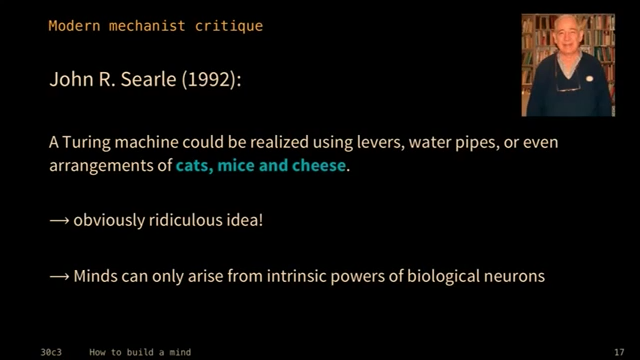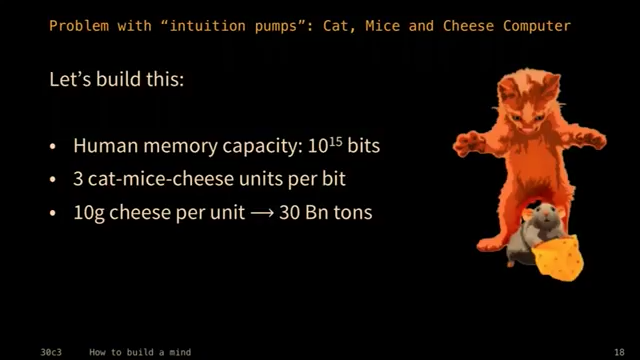How to Build a Mind
Table of Contents
Notes from How to Build a Mind - 30c3 by Joscha Bach 0:01:08 Overview
1. Why should we build AI? - to learn about mind
1.1. Not for cool application but to learn about mind
This has to be given in framework of AI.
1.2. Why Artificial Intelligence? - Only computer science has the right toolsp
Goal: Understanding the mind by building a testable theory
Similar to physics: theory that can be formally expressed and simulated
Of course, computer science alone cannot do it!
1.2.1. Phisophy of mind doesn't have tools to create testable theory
1.2.2. Neuroscience looks at an possible implementation - Looking at wrong level
1.2.3. Psychology ??
Unfortunately psychology had an accident aong the way. Hemholtz, Vagner?, … did good experiments but at same time Psychoanalysis came along
- Psychoanalysis is a not a natural science its a Hermetic Science
We can't disprove it scientifically.
- Then psychologists wanted it to become natural science
0:05:34 So, psychology became the study of human behaviours and thus looking at mental behviour is somehow unscientific. 0:05:38 Some (Skinner) beleived there's no Mental Representation
- Psychology is all about experiments (nowadays)
1.3. Minds are information processing systems - and CS is science of Information Processing
(not chemical, biological, social, ecological, …) and Computer science is the science of information
1.3.1. Is AI Not Dangerous?
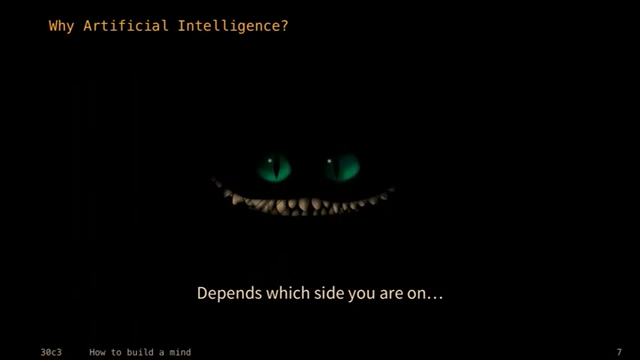
- Intelligence is not evil or bad; Motivation determines that
Having a mind is not a reason to do anything.
Being motivated is: and We are hardwired by evolutionary process (social, striving for power, …)
- AI can have arbitary motivational systems
- Its going to be Organizational AI: Universities, Governments, …
1.4. AI gives perspective for understanding ourself - For Enlightenment
2. How can we build AI?
2.1. Are minds computation? - Yes
2.1.1. Mind and Matter - Rene Descartes - Res Cognitans vs Res Extensa
Rene Descartes Thinking Substance vs Located Substance For Decartes - Mind must be independent.
- Idealist - mind is primary
- Materialist - matter is primary
- Dualism - both exist in parallel
- Crypto Dualism - Present View
Rooted in Christian Religion which surmizes that there is real domain (metaphysical domain where we really are) and there is a physical world (which is not real, its like World Like Wordcraft). In chirstianity this goes a step further that there is someone (God) with root rights and he created this world. But there's another one (the Devil) with root rights.
Not much found in China or Japan. There isn't skepticism of AI.
Domain of the mind souls, phenomenal experience, values, normativity, spirituality
Domain of the physical world mechanical: things, bodies
- God and Devil both have root rights. Devil is the hacker.
- We are now atheist. So we are now NPC (Non Player Characters)
- Leibniz - Describing mind based in Physicalism is bound to fail
Mechanist Explanations
Gottfried Wilhelm Leibniz, 1714: Perception, and what depends on it, is inexplicable in a mechanical way, that is, using figures and motions.
Suppose there would be a machine, so arranged as to bring forth thoughts, experiences and perceptions; it would then certainly be possible to imagine it to be proportionally enlarged, in such a way as to allow entering it, like into a mill. This presupposed, one will not find anything upon its examination besides individual parts, pushing each other—and never anything by which a perception could be explained.
- God and Devil both have root rights. Devil is the hacker.
2.1.2. Turing Machine
2.1.3. Lambda Calculus - Alternate to Turing Machine
Turing machines give an intuition of linearity, how will there be concurrency, ….
0:20:45 - It became lambda because of typesetting problem :rofl:
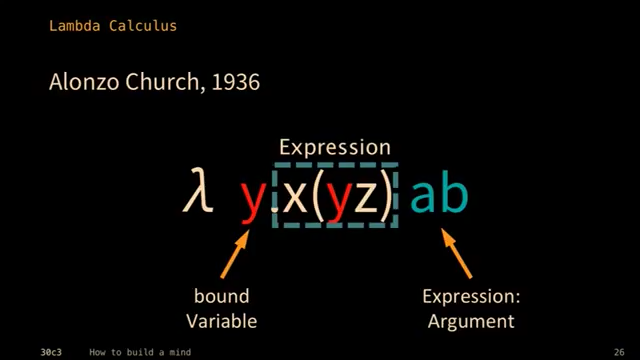 cut argument and paste it in place of bound variable inside expression.
So, lambda calulus is more of a - cut and paste thingy.
cut argument and paste it in place of bound variable inside expression.
So, lambda calulus is more of a - cut and paste thingy.
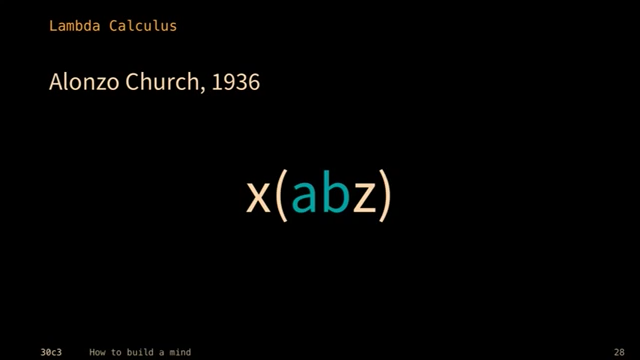
2.1.4. Church-Turing Thesis
- Turing machines can compute Lambda calculus
- Lambda calculus can compute Turing machines
— equally powerful!
We have found other methods of computation:
- Mathematical proofs
- Partial Recursive function
- POS machine - a variation of Turing Machine
Church-Turing Thesis: All definitions of computation have the same power
2.1.5. Brains are turing computational too!
Principle of Neural Information Processing are computational -
- Compartment models
- Integrate and Fire model - Simplification
- Artificial Neural Network (Weights, Bias, Transition function) - Crude Simplification
2.1.6. Weak Computationalism - Minds are computer programs
- Minds are computer programs (realized in neural hardware configuration and individual neural states)
- Mental content is represented in these programs - Program as Data
- Perception encodes information given at the system boundary of the mind as mental content
- Thinking, feeling, dreaming, … are aspects of operations over mental content
2.1.7. Strong Computationalism - Universe is a computer
All the universe can do to us is:
- present information
- produce regularities in this information (i.e. compute)
No conceptual difference between reality and a computer program
2.2. Computationalism - Universe is a pattern generator - Universe can compute
2.2.1. Computationalism is a new kind of Monism (Not Idealism or Materialism)
Neither mind is primary nor is physical world, computation is primary.
- Only information is primary
- Mind and matter are constructions (encodings) over information
- All regularity in perceived information can be captured in computational models
2.2.2. Criticism of Computationalism
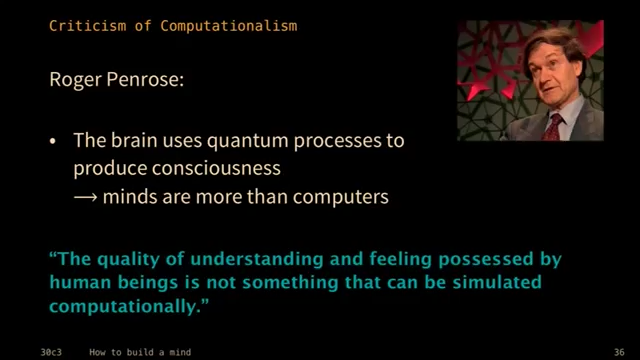
Roger Penrose:
- The brain uses quantum processes to produce consciousness
— minds are more than computers
“The quality of understanding and feeling possessed by human beings is not something that can be simulated computationally.”
0:27:41 But quantum process are computational too!
2.3. Mind are less than Turing machines - because finite tape, finite steps,
0:29:17 for finite state and time - Lambda calculus can calculate more than turing machines
2.4. But note that Effectively Computable function ≄ Efficiently computable functions
- Some problem computers can't solve - halting problem
- Some problem unsolvable in practice (for deterministic turing machine)- NP hard problems
2.4.1. Non-decidable problems - But humans can't solve them either
Test question: can you solve undecidable problems?
If you choose one of the following answers randomly, what is the probability that your answer is correct?
- 50%
- 25%
- 100%
all of the above25%
3. When is Al going to succeed (if ever)?
3.1. How Difficult is AI?
3.1.1. Cortical Column
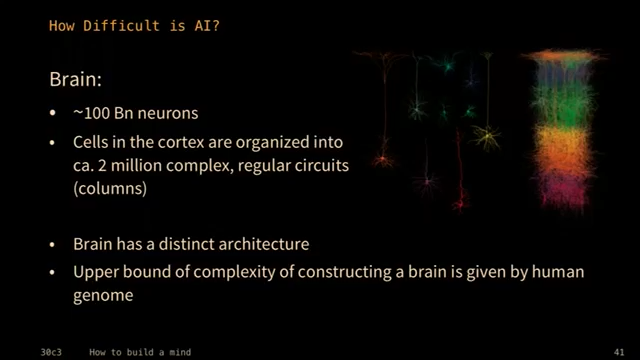
How Difficult is AI?
~100 Bn neurons
Cells in the cortex are organized into ca. 2 million complex, regular circuits (columns)
- Brain has a distinct architecture
- Upper bound of complexity of constructing a brain is given by human
3.1.2. Human genome fits in CD rom - ~700MB
0:32:03
0:32:05 Computation complexity of complete human being is less than Microsoft Windows (If Physics and Chemistry are given) 0:32:24 Its the Upper bound because neurons are just a part of it 0:32:29 Its not easy to reverse engineer - its just not hopeless
3.1.3. Without specification we don't know how hard the problem is or how long it takes
3.2. AI history
The Way to Artificial Intelligence
- Logic, Automata: Peirce, Boole, Tarski, …
- Computability: Turing, Church, Post, Gödel
- Computers: Babbage, Zuse, von Neumann, ..
- Information Theory: Shannon
- Programming Languages: McCarthy, Rochester, ..
- Cybernetics: Wiener, Ashby, … - Idea of system made up of entities and relations between them and within them there is feedback and dynamic system emerge. Unfortunately its being killed by second order cybernetics and turned into humanity and died. 0:34:25 But the idea stuck around and most of them went to AI
- Symbol Systems: Newell, Simon, …
- Neural Networks: McClelland, Pitts, …
- Autonomous, situated Agents: Minsky, Brooks, .. - Self directed, goal directed system
3.2.1. Started with ~1950 Alan Turing's Paper - Computing Machinery and Intelligence (READ THIS PAPER)
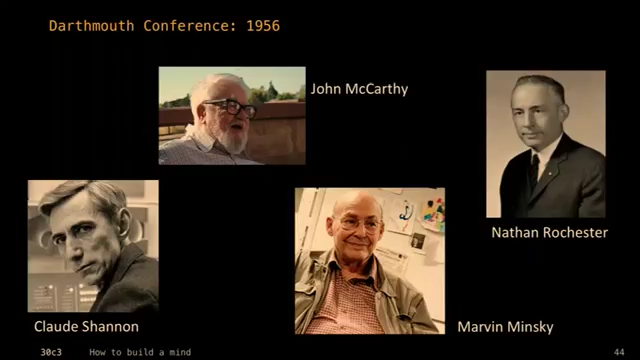
0:36:17 Marvin Minsky coined AI at Darthmouth Conference - 1956
3.2.2. AI eras
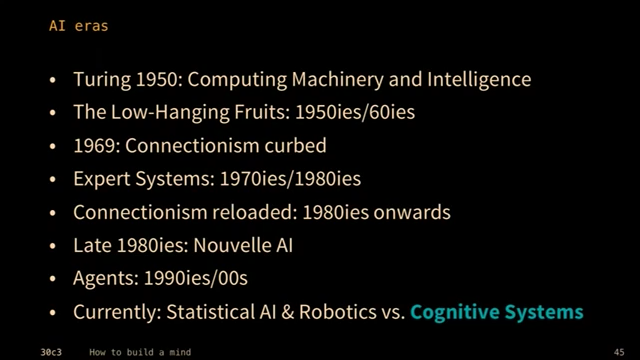
Marvin Minksy wrote against neural networks - they won - so for most of the time there was no progress in that part for about a decade
- 0:37:31 Expert systems gave diminishing returns
3.2.3. Nowadays the idea is of Cognitive Systems
4. What are the ingredients for AI? - Cognitive Systems
aka AGI aka Bilogically inspired Cognitive Architecture aka Cognitive Artificial Intelligence
- Uses Information Processing as dominant paradigm to understand the mind.
Methods should focus on components and performances necessary for intelligence:
- Whole, testable architecture - Not individual modules
- Universal Representations: Grounded neuro-symbolic representations (integrate both symbolic and distributed aspects , associative)
- (Semi-) Universal Problem Solving: - Semi because humans are also not good at solving all problems Learning, Planning, Reasoning, Analogies, Action Control, Reflection …
- Universal Motivation: - something to direct the system to sth interesting Polythematic, adaptive goal identification
- Emotion and affect
4.1. Universal Mental Represenatation
We need universal mental represenation
- we should be able to do operations on them for problem solving
- 0:39:55 they can be mapped to perceptual input
- 0:40:05 they need to translated to motor programs to perform actions
0:40:12 feedback between action and input is the Environment
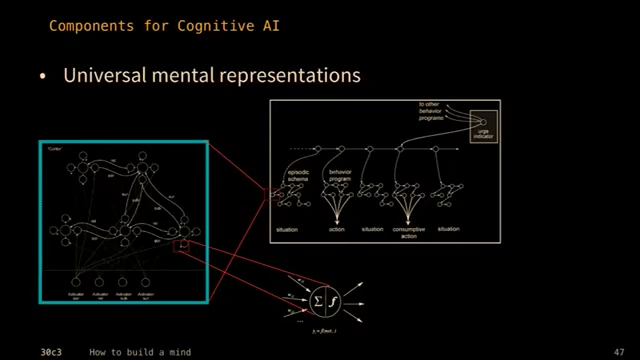
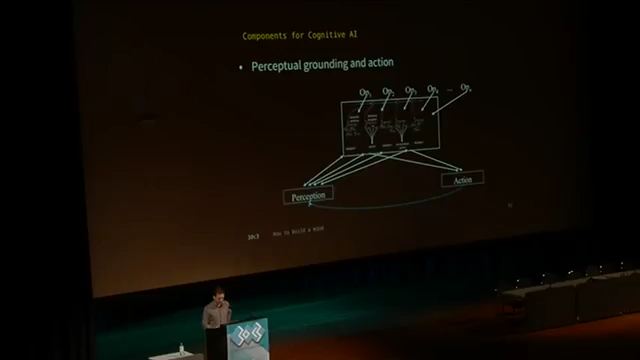
4.2. Mental Represenation have structure
- model of current situation - Situation Model
- model of past - Protocol memory
0:40:40 Protocol Memory - Memory of Past
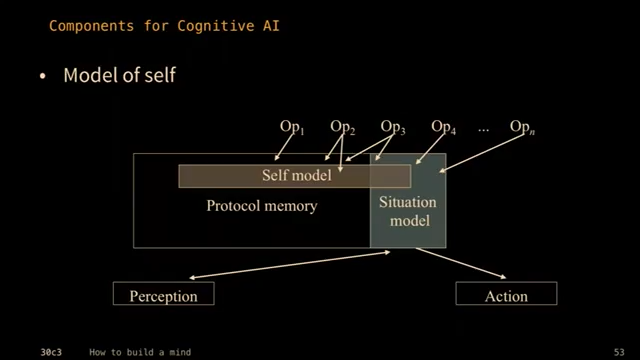
A part of protocol memory is Self model
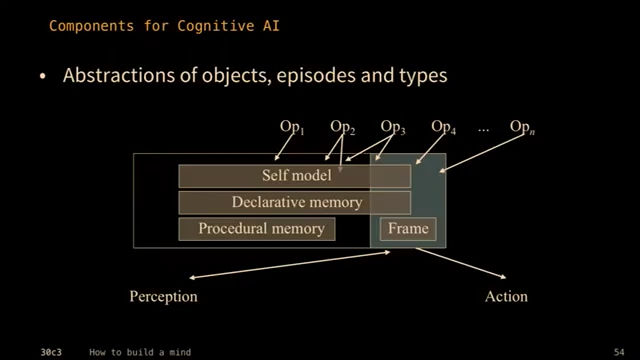
- Frame - Context
- Frame extends to the future - expectional horizon
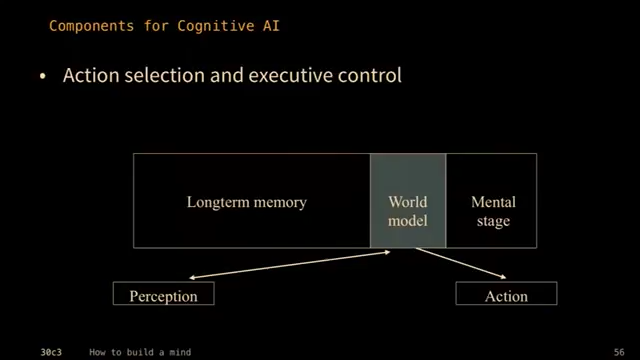
0:42:02 Generalize:
- longterm memory
- World model
- Mental stage - the future
4.3. Action Selection and Executive Control
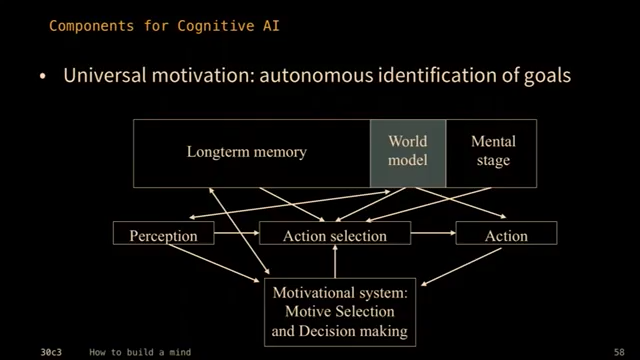
- Actional Selection - mediates between perception and action
- Motivation system - the mechanism that controls action selection
- based on motives of the system
- motives are based on demands 0:42:22
4.4. Motivational System - Demands
We are not born with our goals. A set of demands in the system produces the goals. Urges/drives (demands) -> Motive Selection -> Intention
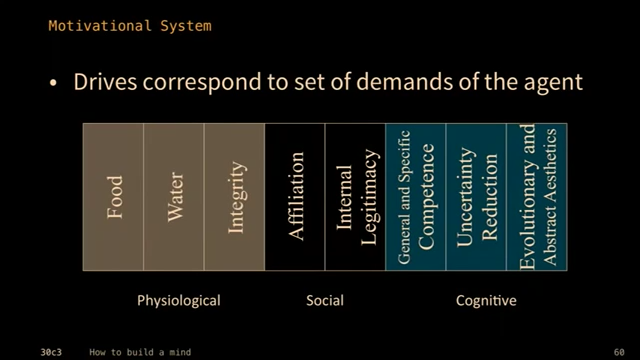
4.4.1. Physiological Demand
- Food
- Water
- Integrity
4.4.2. Social Demand
they structure our social interaction
- Affiliation
- Internal Legitimacy
4.4.3. Cognitive Demand - , Reduce Uncertainity
- Competence Acquisition - Demand to Learn
- Reducing uncertanity
For mathematicians they find pleasure in solving uncertanity and they find other uncertainity. So for them, mathematics is the source of unending pleasure.
- Aesthetic Demands
0:45:33 Abstract Aesthetics - Relates to finding better represenatation, finding structure
4.5. Emotional in Cognitive System - Modulation and Affect
How is it possible for a system to feel something?
4.5.1. Emotion is a configuration of system in several dimension
- state of arousal
- direction of attention (inwards for outwards)
- resolution level
4.5.2. Difference in perception is Feeling
these dimensions regulate/modulate our congnition. so we experience, understand something differently
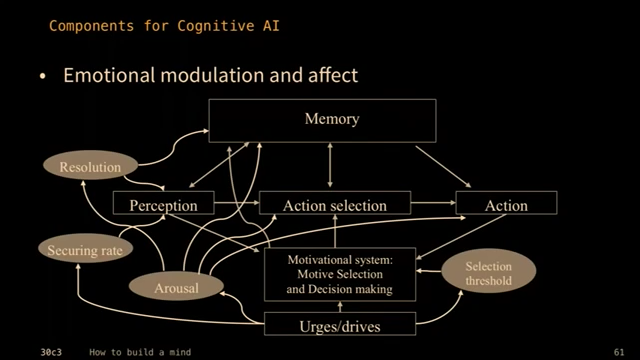
4.5.3. Affect - configuration of cognitive system
Emotion in Computation Models
- Affect can be seen as a configuration of a cognitive system
- Modulators of cognition:
- arousal, selection threshold, securing threshold, resolution level
- estimate of competence and certainty
- pleasure/distress signals - valence
- Affective state is emergent property of modulation
- 0:47:37 Directed affects (higher-level emotions) (jealosy, pride,…) emerge by association of demand with appetive or aversive objects/situations
4.6. Incremental Progress or Big Jump? - Incremental Progress
Things to do What are the ingredients for AI? - Cognitive Systems!
- 100s of PhD thesis
- entirely doable
- but its going to take a very long time
0:49:22 We are going to realize we are full of shit. :rofl:
5. What should you do - to get into AI
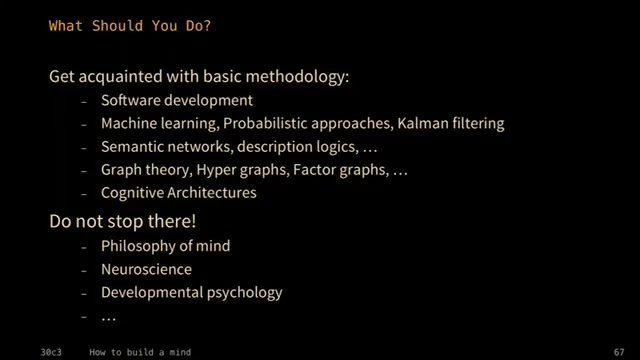
Get acquainted with basic methodology:
- Software development
- Things we have done so far - Machine learning, Probabilistic approaches, Kalman filtering
- Modes of Representation - Semantic networks, description logics, …
- Graph theory, Hyper graphs, Factor graphs
- Cognitive architecture - building computation model to simulate psychological phenomena and test them
Do not stop there!
- Philsophy of mind
- Neuroscience
- Developmental psychology
0:50:19 Graph Theory! Hyper Graphs! 0:50:46 Study Cognitive Science
5.1. Open Problems
5.1.1. Representations
- abstract and perceptual,
- how to work with ambiguious
- superpositional
- inheritance and polymorphism,
- any-time construction (using constraints)
including temporal relations, loops, etc
0:51:28 Constraints for Partial Represenatation ??
5.1.2. Preception
- bottom-up - cue driven - driven by environment - what we see
- top-down: theory/concept driven - driven by what we expect to see
- works on sensory input and memory
- any-time characteristics => works on partial representation??
5.1.3. Categorization
- Saliency (Similarity and Dissimilarity)- driven
- Goal - driven
- Social (from input from others)
5.1.4. Universal Problem Solver
We want to have general solutions
5.1.5. Language!
organizing mental represenatation (which are probably Fuzzy distributed hypergraphs) into discrete strings of symbols
5.1.6. Sociality - Interpreting others
- theory of mind
- Personhood and Self concept
- personality properties
5.1.7. Integration
- how to integrate analytical and associative operations work together
- Attention management
- complete system insetad of isolated modules
- 0:54:12 Developmental trajectory - start with kids and grow to be more adult like
- persistence - system should be stable
5.1.8. Benchmark Problems - Find a benchmark for mind!
- Must enforce universal problem solving, representation, perception
- Must support incremental development
- Focus on child performance first
- Allow for comparison between approaches
- Inspire a productive research community
- Attract funding
